The Great Storm of October 1987: Stories and pictures from a night that changed Britain
It's 30 years since the Great Storm of 1987 wrought havoc across England and Wales – we've brought together stories from some of those who lived through it.
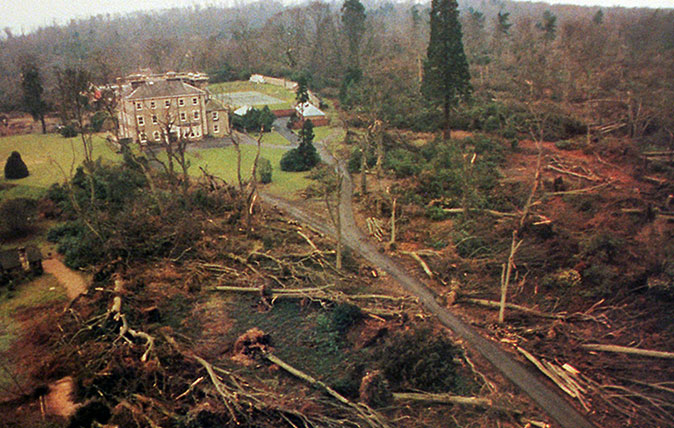
30 years ago today, I was woken at 4 o'clock in the morning by a truly ungodly noise. My dad had been roused from sleep as well, and we both went downstairs to investigate.
The wind howling around the house – a 1930s semi in the far-flung reaches of suburban South London – was like the scream of a banshee, and as we got into the kitchen it was clear that something strange had happened. My mother arrived to join us in the kitchen just as Dad opened the back door to investigate further; as soon as he turned the handle, he was thrown backwards in a whirl of wind, rain, noise – and leaves. Lots and lots of leaves.
It turned out that the our beautiful old chestnut tree, almost 100ft of it, had fallen down, destroying the shed and crashing onto the house.
After several minutes battling with soaking wet branches and leaves we managed to stuff the attacking tree back out of the door and get it closed again, after which we waited until morning to see what on earth had happened, peering out of the windows until dawn.
My sister slept through the whole thing, incidentally, then complained when she woke up that the phone wasn't working. Teenagers at least were the same in 1987 as they are in 2017.
We were actually lucky: the tree falling on our house did damage, but caused no injury. It was as nothing to some of the carnage wrought by that incredible storm across the south of England. Nearby Oaks Park, in Carshalton, had consisted of dozens of acres of dense woodland; it emerged that morning looking like a First World War battleground.
The storm – not technically a hurricane as it originated in the Bay of Biscay – hit everywhere from Cornwall to the Wash, but the south-east corner of England was worst hit. Roofs and chimney pots flew through the sky, boats were dashed against harbour walls and trees were ripped to pieces or ripped out of the ground.
Sign up for the Country Life Newsletter
Exquisite houses, the beauty of Nature, and how to get the most from your life, straight to your inbox.
At Folkestone a passenger ferry was washed ashore, while in the port of Dover a ship was blown over. Such incidents demonstrate how much worse the death toll might have been had the storm hit during the day.
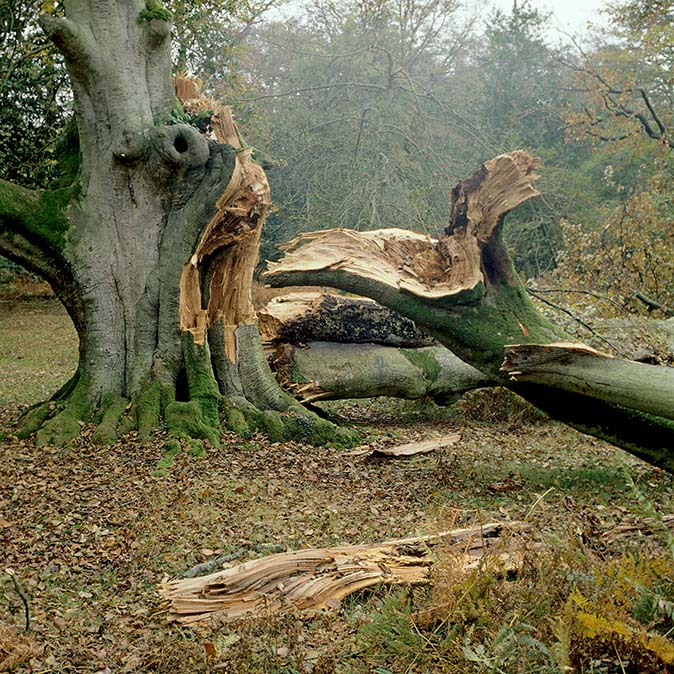
Down our street, trees had fallen all across our street – all of which dad managed to pull to one side in an attempt to get me to school. Eventually he got me about half a mile of the three-mile journey, only being beaten by vast oak tree that blocked the main Brighton Road in Purley.
'Well that's not too bad – you can walk from here,' he declared, cheerily.
What else could I do? I walked the rest of the way, and was the only one of 1,000 pupils who made it in from further than about 500 yards away. I was 11, it was the ultimate unexpected 'snow day', and I spent it in the company of 40 or so hardy souls of ages from 10-18, and a baffled handful of teachers – most of whom had never spoken to me in their lives. Funny what you focus on when you're 11; I'd have a different perspective on the appalling death and destruction now.
The storm of 1987 is one of those great 'where you were' moments for anyone who lived through it. Here are half dozen stories of others who lived through that night.
Michael Fish, broadcast meteorologist

I drove to Television Centre from my west London home via Chiswick at about 4.30am. I didn’t realise that a storm was raging because I stuck to main roads with no trees lining them. There probably was damage, but it was dark and I couldn’t see it. Once at the studio, I remained ensconced inside for hours and news of the storm was slow to filter through.
By lunchtime, when I finished my shift, people had started to ring in with information. The forecast I gave has plagued me, not helped by the fact that the following day was a Saturday, so no one was in the press office and stories were made up in the media. On the plus side, the only damage to my house was a bent TV aerial.Scene of devastation: the National Trust property Emmetts House and Garden at Ide Hill, Kent, had 95% of its woodland destroyed.
However, there was a positive aftermath: the Great Storm prompted heightened awareness of the value of UK forestry and more than 500 million trees were planted in compensation, many of them broad-leaved, which provided greater variability than the previous dense conifer cover had.
Tony Kirkham, arboretum supervisor at the Royal Botanic Gardens, Kew
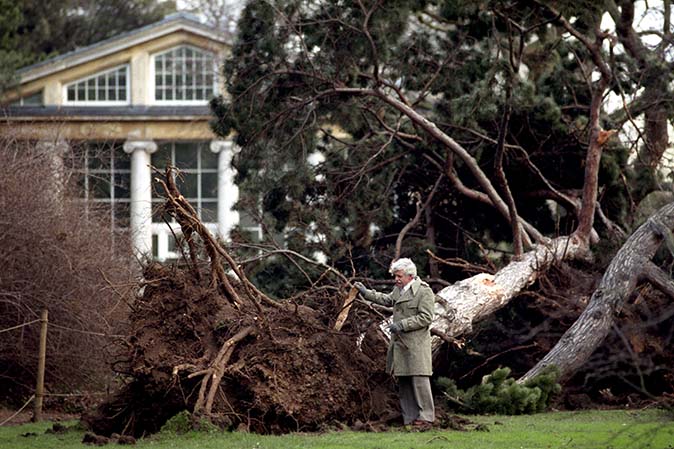
A tree was blocking the Jodrell Gate, the usual staff entrance, when I turned up. A colleague said: ‘You won’t want to come in.’ I saw some of the 700 trees we lost that night and experienced a terrible sinking feeling.
One of my favourites was a big chestnut-leafed oak and the first thing I did was go and see if it was still standing – it was, although 20 others surrounding it on the same lawn had fallen. What surprised me were the huge branches that had been ripped off and dropped 50 yards away.
At the time, it was all doom and gloom at Kew, but, looking back, it was one of the best things that could have happened. We lost what we needed to lose, it taught us so much and awakened in the British people the understanding that we need to look after our trees.
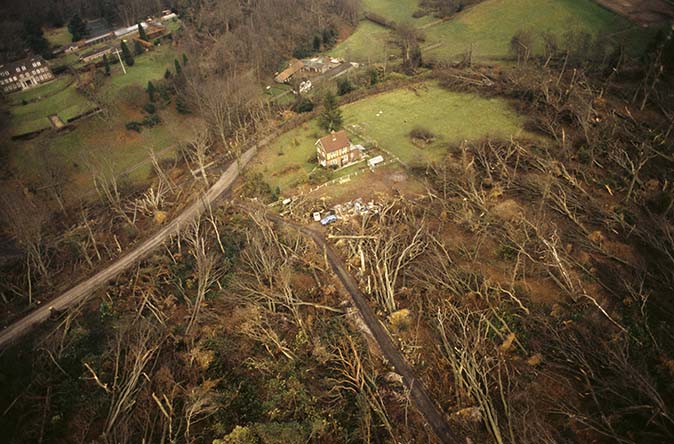
Monica Akehurst, farmer, Herstmonceux, East Sussex
My husband, Fred, and I found that we were trapped by uprooted trees when we tried to drive from our house to our yard a couple of miles away, so we walked across the fields. On arrival, we discovered a scene of devastation: the roof of our Dutch barn had blown on top of a timber barn, flattening it. Fortunately, the cattle were out or they would have been killed. When we reached them later, they were unscathed.
The clear-up took weeks and we had to be wary of live electric cables. We lost trees and suffered broken fences, but other people’s herds escaped that night, a local chicken farmer’s poultry blew away and isolated dairy farmers had to throw their milk down the drain. We came off fairly lightly.
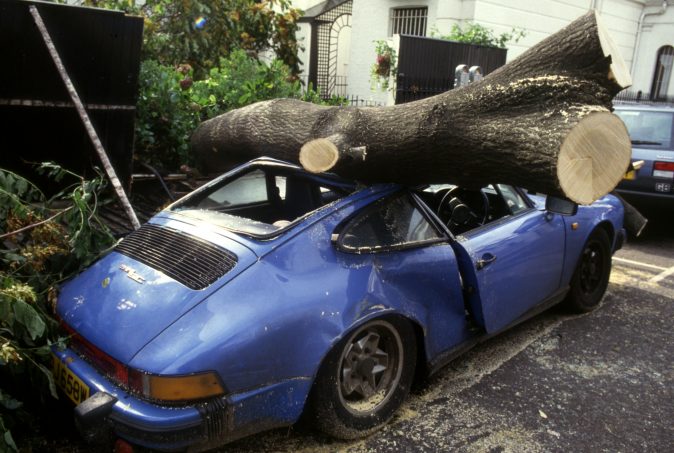
Paul Redsell, National Trust warden at Leith Hill, Surrey
I walked to Leith Hill Tower, the highest point in south-east England, the day after. Trees were strewn everywhere and, as I climbed the tower, I expected to see large swathes felled like matchsticks. However, there were gaps where the wind had dipped into the valleys and taken out a few here and there.
The tower itself, built in 1765, was completely unscathed. The same couldn’t be said of Leith Hill Place’s formal gardens, the life’s work of gardener Peter Collins. They were devastated on a grand scale – ripped apart – and, sadly, Peter died the following year.
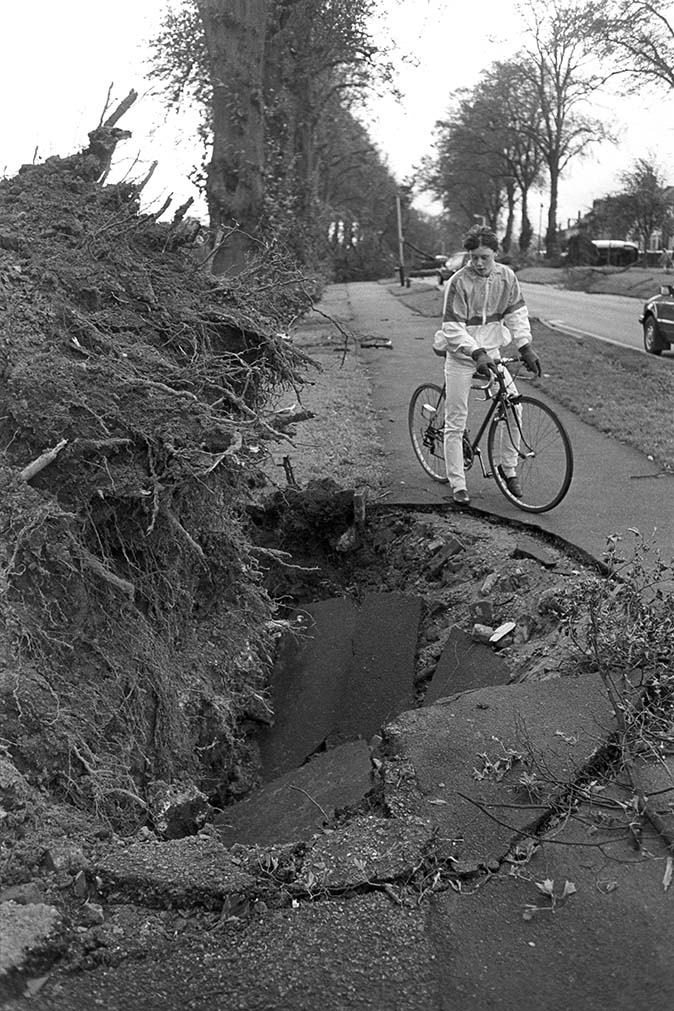
Mark Hayward, ranger supervisor, South Downs Conservation Project
Not all the trainee rangers could reach our base in Lewes that morning, so a small team, armed with chainsaws, headed to Seven Sisters Country Park via bridleways as the roads were blocked.
I saw total devastation. Anything growing in Stanmer Park had been flattened, trees had concertinaed on top of each other on old cart tracks and the pockets of woodland dotted along the open, eastern landscape of the South Downs were all affected.
It looked like the Somme in places and it was humbling to realise that such a brief storm could cause that much devastation.
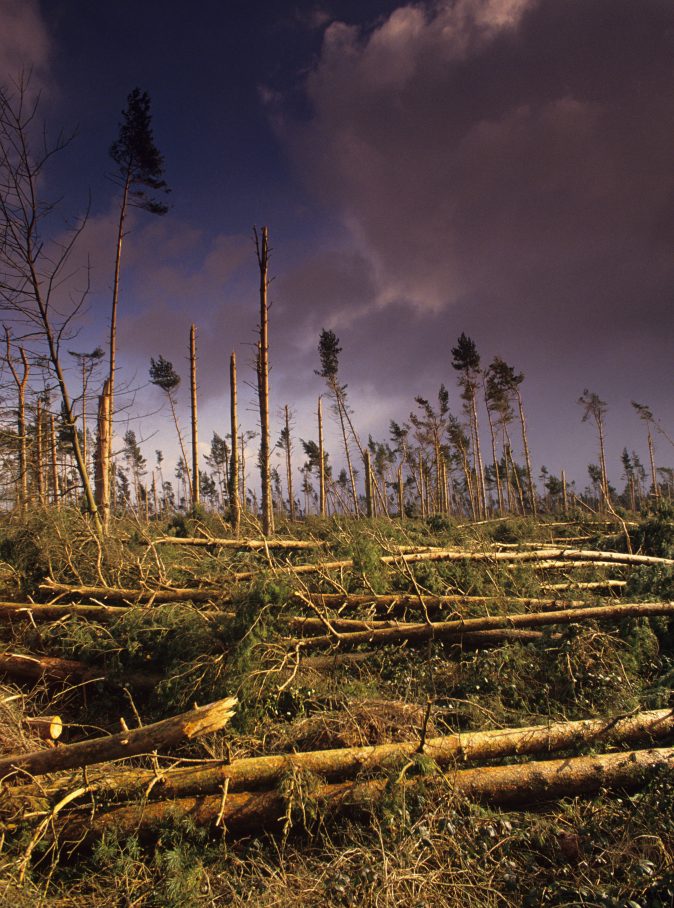
Bob Ogley, editor, Sevenoaks Chronicle, Kent
The night before, the landlord of my local pub had showed me his barometer and told me not to walk home through the woods. I didn’t realise then that I was going to be the last person to see trees standing on Toys Hill. By morning, they were all gone.
I was woken during the night by a noise which sounded like an express train coming into the bedroom. It would attack and then fade. Giant flashes turned out to be trees falling on power lines. My wife and I sat in the centre of our house waiting for it to be hit, but although our car was flattened, the house survived.
In the morning, I climbed and crawled the four miles to the newspaper office in Sevenoaks, the town completely cut off by fallen trees. My reporters greeted me with ‘Welcome to One Oak’.
I managed to book a plane from Biggin Hill on an emergency telephone and took pictures from the air of those six fallen oaks near the Vine cricket ground (above left). It was a symbol of what had happened and was immediately in demand from TV stations and newspapers.
The storm was the biggest story we’d ever covered – the Chronicle sold 50,000 copies, four times our usual circulation.
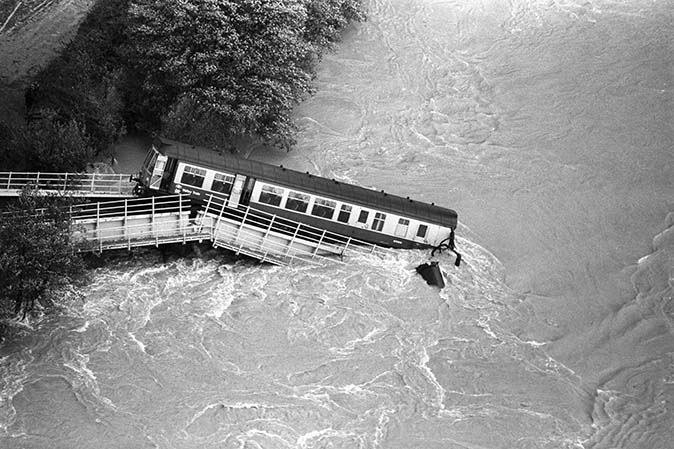
Keith Brewer, head gardener, Ventnor Botanic Garden, Isle of Wight
The night before, I’d been trimming branches from evergreen oaks. It was eerily calm. Twelve hours later, it was a scene of devastation. Every tree and delicate shrub, sourced from all over the world from the 1970s onwards by Sir Harold Hillier, had been knocked over, including tulip trees and the rare ginkgo (fossil) tree.
For me, the saddest thing was the loss of the Norfolk Island pine that had been planted by Earl Mountbatten when he opened the garden in 1972. It was as if the trees were skittles.
My immediate thought was that it was the end of the garden, which had been so rich. It was definitely the end of that era and, although it was regenerated, it was never the same again.

Mark Hedges, bloodstock researcher at Tattersalls
I was woken in the night by a telephone call: the yearlings stabled at Tattersalls’ Newmarket base for the following day’s sale were terrified and needed calming. On my way to the stables, the sky was lit intermittently by bright flashes as power lines fell to the ground. The noise of crashing trees was incredible and the air was filled with flying objects – it felt like being in a giant tumble dryer.
I spent the rest of the night holding horses’ heads, attempting to alleviate their panic. I emerged to an incredible scene in the morning: fallen trees everywhere, including avenues planted during the Napoleonic Wars. It felt as if there had been a bomb blast and the whole world had been turned upside down.

31 of the most spectacular properties for sale in the world right now
From eye-popping New York penthouses to French country houses where you'll scarcely believe what you can get for your money,
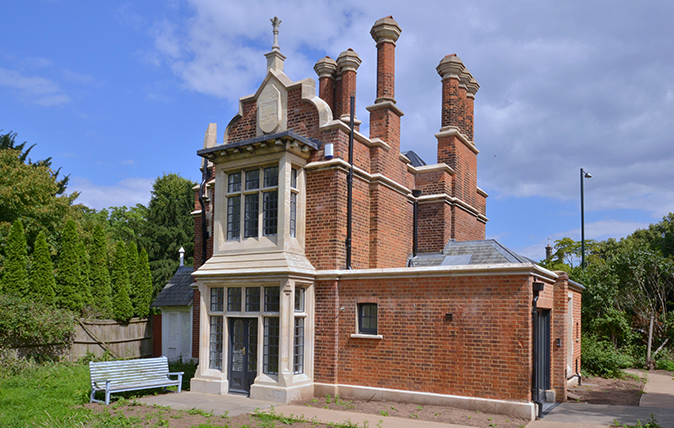
Kew Gardens to rent out a lodge within the grounds for the first time in its history
Kew has several beautiful buildings on site, but they have never rented them out to the public. Until now.
Toby Keel is Country Life's Digital Director, and has been running the website and social media channels since 2016. A former sports journalist, he writes about property, cars, lifestyle, travel, nature.
-
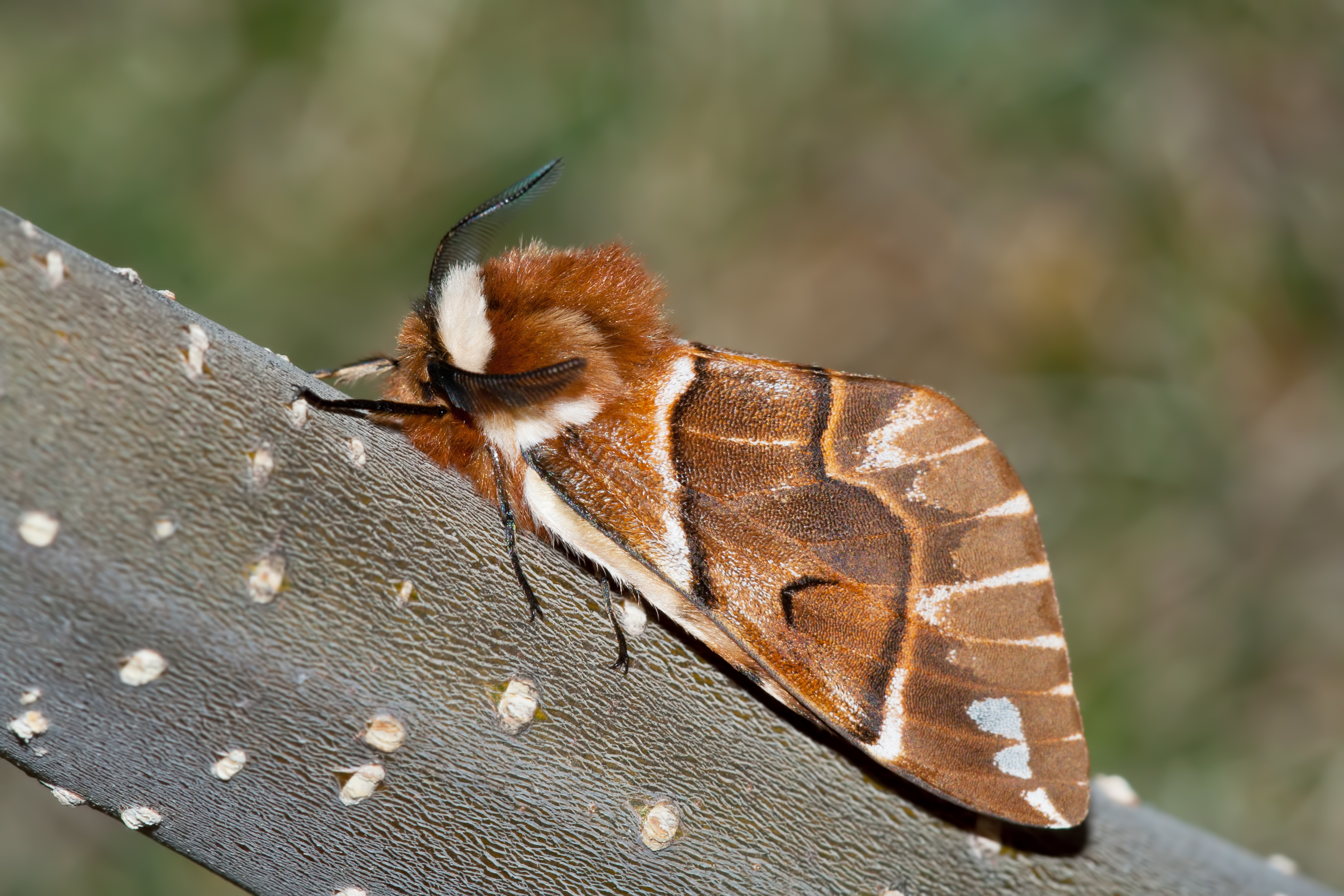 In all its glory: One of Britain’s most striking moth species could be making a comeback
In all its glory: One of Britain’s most striking moth species could be making a comebackThe Kentish glory moth has been absent from England and Wales for around 50 years.
By Jack Watkins
-
 Could Gruber's Antiques from Paddington 2 be your new Notting Hill home?
Could Gruber's Antiques from Paddington 2 be your new Notting Hill home?It was the home of Mr Gruber and his antiques in the film, but in the real world, Alice's Antiques could be yours.
By James Fisher
-
 In all its glory: One of Britain’s most striking moth species could be making a comeback
In all its glory: One of Britain’s most striking moth species could be making a comebackThe Kentish glory moth has been absent from England and Wales for around 50 years.
By Jack Watkins
-
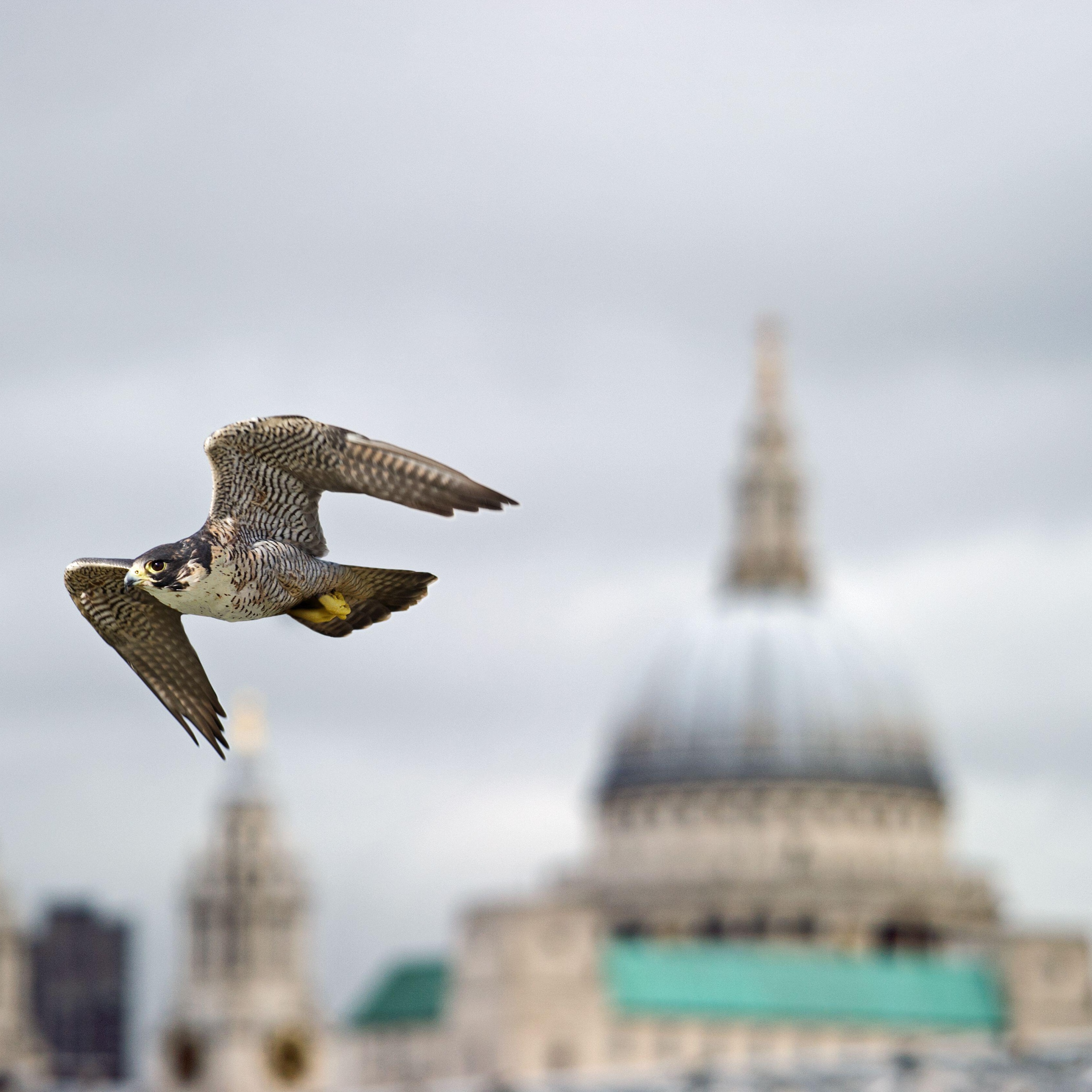 The birds of urban paradise: How to get twitching without leaving the city
The birds of urban paradise: How to get twitching without leaving the cityYou don't need to leave the concrete jungle to spot some rare and interesting birds. Here's a handy guide to birdspotting in Britain's towns and cities.
By Richard Smyth
-
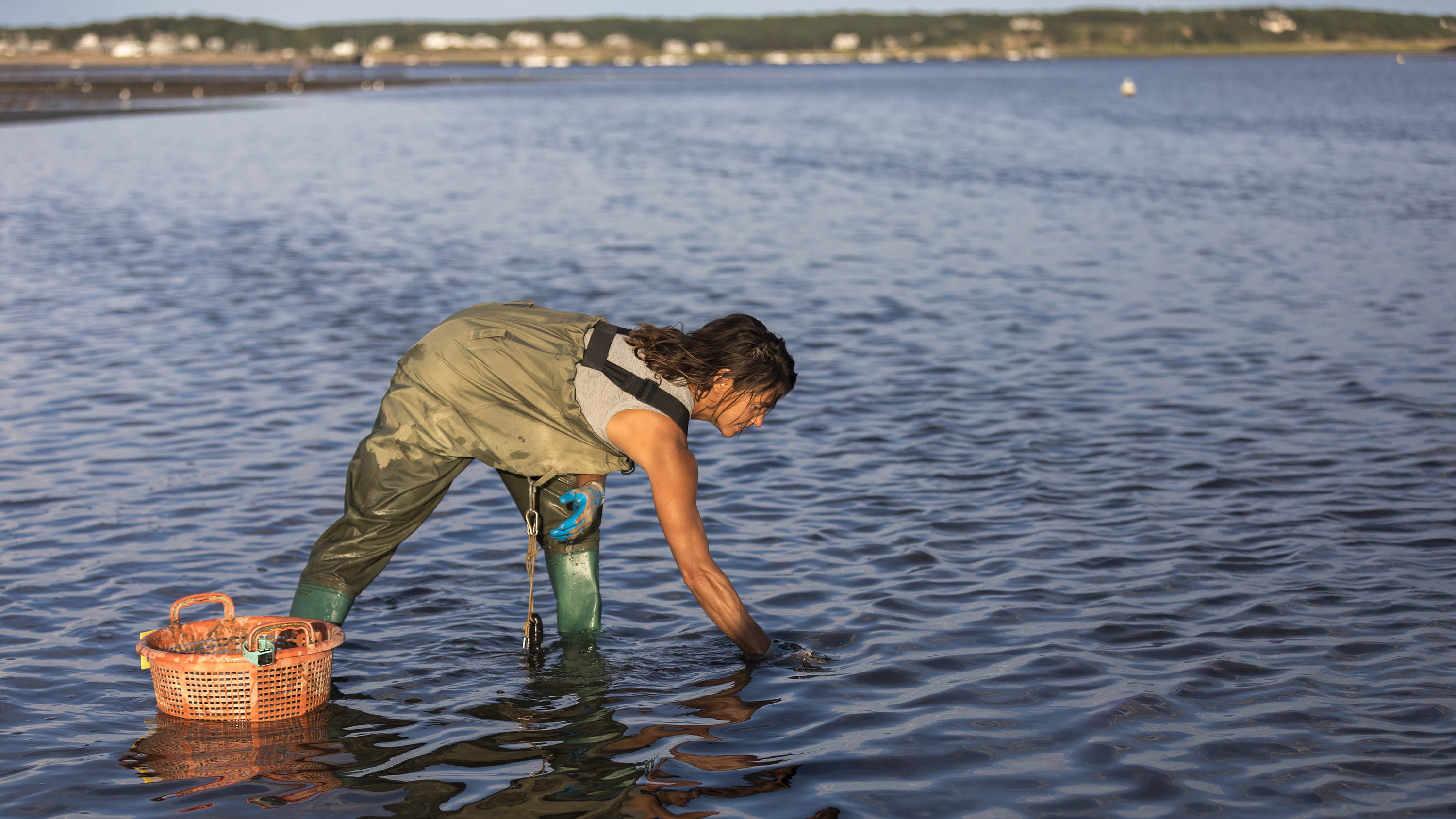 Food with a pinch of salt: The crops we can harvest from the sea
Food with a pinch of salt: The crops we can harvest from the seaFilling, rewarding and nutritious, vegetables and plants grown in saline environments — whether by accident or design — have plenty of potential. Illustration by Alan Baker.
By Deborah Nicholls-Lee
-
 White-tailed eagles could soon soar free in southern England
White-tailed eagles could soon soar free in southern EnglandNatural England is considering licensing the release of the raptors in Exmoor National Park — and the threat to pets and livestock is considered to be low.
By Jack Watkins
-
 Britain's whale boom and and the predator that's far scarier than a great white shark, with wildlife cinematographer Dan Abbott
Britain's whale boom and and the predator that's far scarier than a great white shark, with wildlife cinematographer Dan AbbottThe wildlife cinematographer Dan Abbott joins us on the Country Life Podcast.
By Toby Keel
-
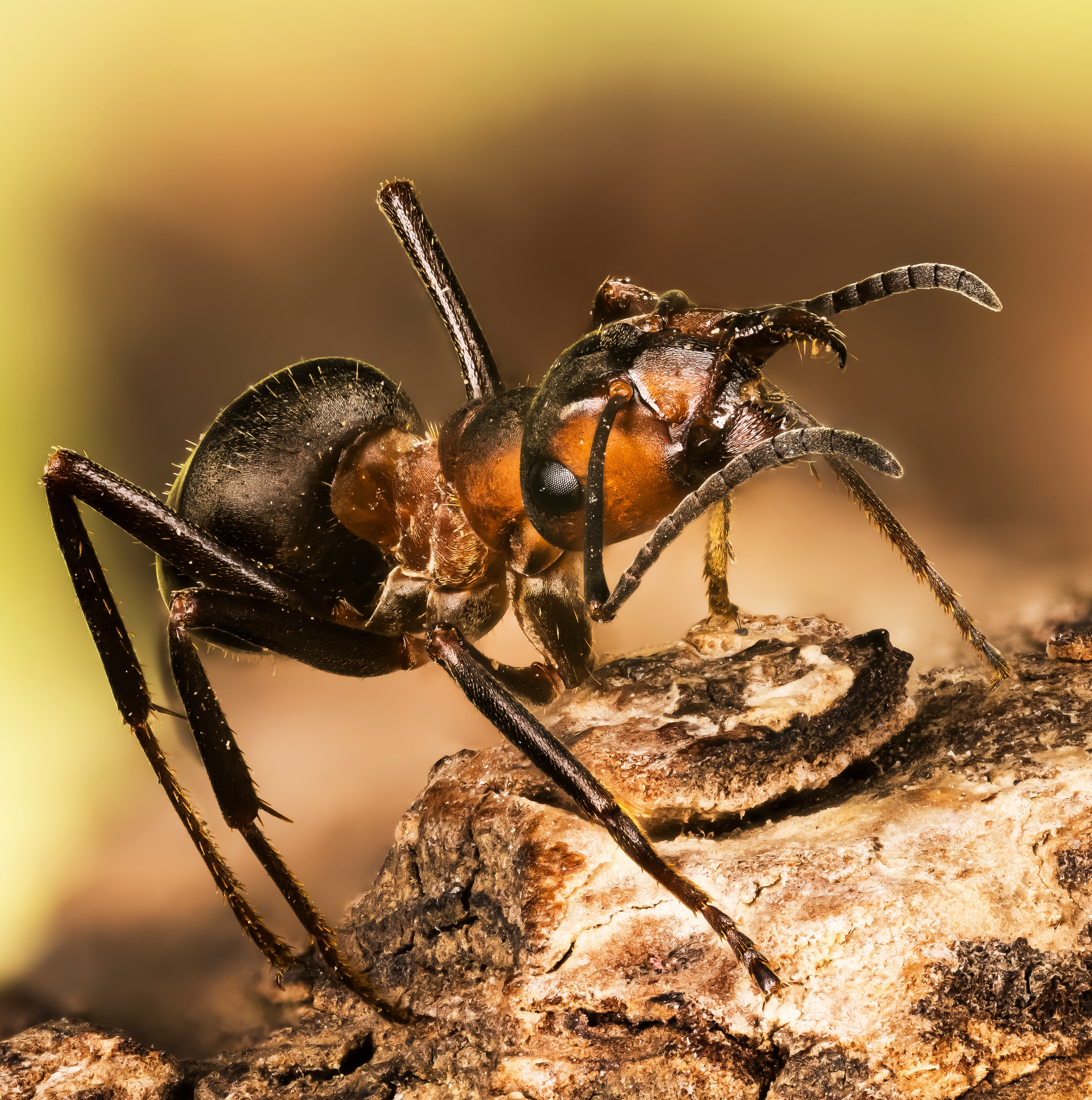 'They are inclined to bite and spray acid to protect territory': Meet the feisty red wood ant
'They are inclined to bite and spray acid to protect territory': Meet the feisty red wood antBy Ian Morton
-
 The King wants YOU: His Majesty's call-to-arms for under-35s across Britain
The King wants YOU: His Majesty's call-to-arms for under-35s across BritainThe King’s Foundation has launched its ‘35 under 35’ initiative — a UK-wide search for ‘the next generation of exceptional makers and changemakers’ who want to work holistically with Nature.
By Amie Elizabeth White
-
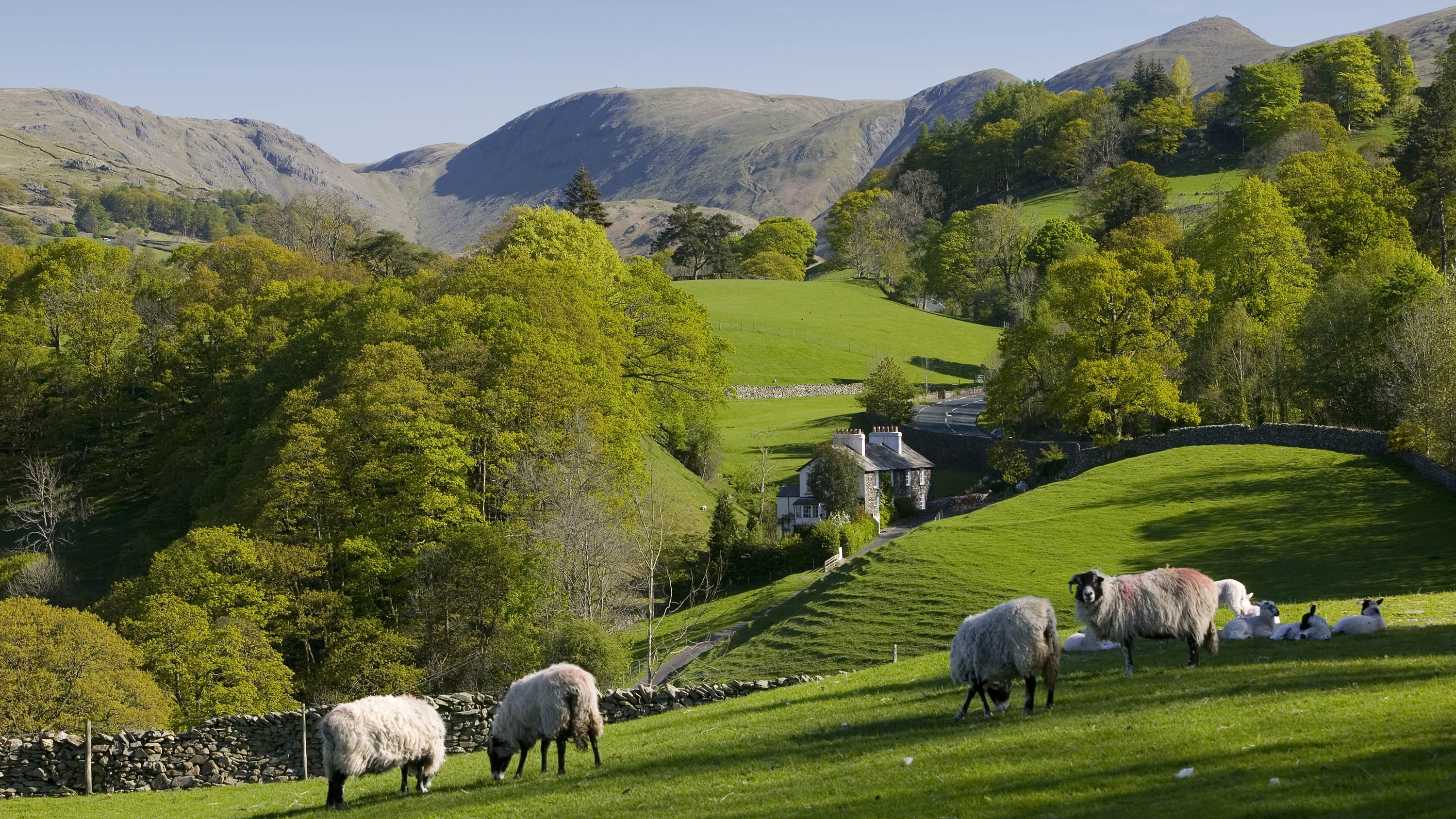 'A big opportunity for a small, crowded and beautiful country': Fiona Reynolds on how the Land Use Framework can make Britain better
'A big opportunity for a small, crowded and beautiful country': Fiona Reynolds on how the Land Use Framework can make Britain betterThe Government’s Land Use Framework should be viewed as an opportunity to be smarter with our land, but conflicts need to be resolved along the way says Fiona Reynolds, chair of the Food, Farming and Countryside Commission.
By Fiona Reynolds
